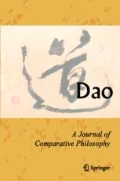Conclusion
To translate the Aristotelian square of opposition into Chinese requires restructuring the Aristotelian system of genus-species into the Chinese way of classification and understanding of the focus-field relationship. The feature of the former is on a “tree” model, while that of the later is on the focusfield model. Difficulties arise when one tries to show contraries betweenA- type and E-type propositions in the Aristotelian square of opposition in Chinese, because there is no clear distinction between universal and particular in a focus-field structure of thinking. If there could be a chance to discuss the analytic identity between the two logical systems, then it might be only constituted during a face to face conversation in the present, or, in other words, in the translation of particular propositions (singular subjective,I-type, andO-type propositions) in a particular case. The best hope for a translator is that in the actual temporally situated practice,now he or she might find a temporary way to map the concepts of one to the other with relatively little loss of structure.
Similar content being viewed by others
References
Ackrill, J. L. 1966.Aristotle’s Categories and De Interpretatione. Oxford: Clarendon Press.
Auyang, Sunny Y. 1998.The Foundations of Complex Systems Theories. Cambridge: Cambridge University Press.
Barnes, Jonathan, ed. 1984.Complete Works of Aristotle. Princeton: Princeton University Press.
—, trans. 1975.Aristotle’s Posterior Analytics. Oxford: Clarendon Press.
Barwise, Jon, and John Etchmendy. 1999.Language Proof and Logic. Stanford: CSLI Publications.
Chang, Tung-sun. 1939. “A Chinese Philosopher’s Theory of Knoweldge.”Yenching Juanal of Social Studies I.2.
Copi, I. M. 1990.Introduction to Logic. New York: Macmillan Publishing Company.
Feng, Qi. 1983.The Logical Development of Chinese Ancient Philosophy Shanghai: Shanghai Renmin Chubanshe.
Graham, A. C. 1978.Later Mohist Logic, Ethics, and Science. Hong Kong & London: SOAS.
Graham, A. C., trans. 1986.Chuang-Tzu: The Inner Chapters. London: Mandata.
Griffin, James. 1964.Wittgenstein’s Logical Atomism. Oxford: Clarendon Press.
Hall, David L., and Roger T. Ames. 1995.Anticipating China. Albany, New York: State University of New York Press.
Tiles, Mary, 1997. “Images of Reason in Western Culture.” InIntroduction to World Philosophies. Edited by Eliot Deutsch. Upper Saddle River, New Jersey: Prentice Hall.
Watson, Burton, tr. 1963.Mo Tzu: Basic Writings. New York: Columbia University Press.
Wittgenstein, Ludwig. 1974.Tractatus Logico-Philosophicus. Trans. by D. F. Pears and B. F. McGuinness. Atlantic Highland, New Jersey: Humanities Press International, Inc.
Yuan, Ke. 1985.The Dictionary of Chinese Myth and Legend Shanghai: Shanghai Cishu Chubanshe.
Author information
Authors and Affiliations
Corresponding author
Rights and permissions
About this article
Cite this article
Tiles, M., Jinmei, Y. Could the Aristotelian square of opposition be translated into Chinese?. Dao 4, 137–149 (2004). https://doi.org/10.1007/BF02871087
Issue Date:
DOI: https://doi.org/10.1007/BF02871087




